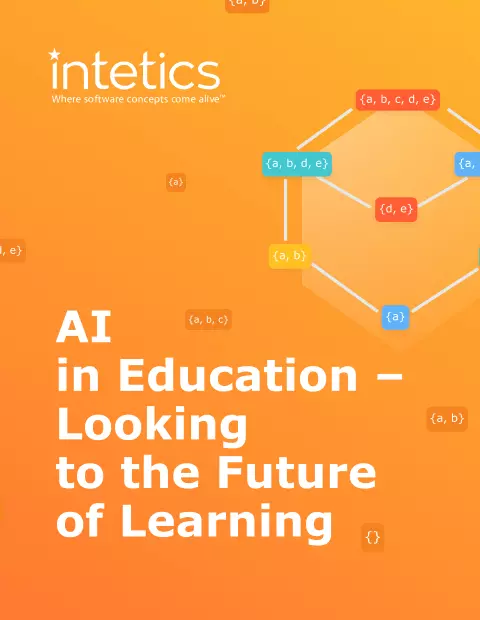
Extended Abstract, Intetics Inc.
4851 Tamiami Trail N, Suite 200, Naples, FL 34103-3098, United States
www.intetics.com
Keywords: Adaptive Learning Environment, EdTech, E-Learning, Knowledge Space Theory, Smart Content
In recent years, AI in EdTech has gained significant traction – districts and teachers are recognizing its potential for delivering a personalized learning experience, as well as its ability to reduce teachers’ overwhelming workloads. In this White Paper, Intetics will examine the technology behind AI EdTech, main application areas, the current and future market, industry resources, and much more. Below, you can find an overview of all topics presented in the White Paper.
I. Introduction
The White Paper opens the Whitepaper with an introduction to the topic of AI EdTech (AIED), explaining how it can be applied to the learning process, including determining and monitoring learning processes, providing personalized learning experiences, and understanding students’ strengths and weaknesses. A brief overview is given on what the White Paper will cover. Get a definition of AIED and how it relates to pedagogy. Lastly, the introduction closes with the scope of AIED – a prediction on how this technology can optimize educational costs and improve learning efficiency.
II. Main Application Areas
Dive into several application areas of AIED, and get an explanation of how the technology is suitable for each one: personalizing education, producing smart content, contributing to task automation, providing tutoring, and ensuring accessibility. This section concludes with challenges present within the AIED industry.
III. Technology Overview
Learn about common terms used within the White Paper, including Adaptive Learning Environment, Big Data, Machine Learning, and Neural Networks. Next, the White Paper addresses the three primary categories of AI in Edtech: instructor-oriented, institution-oriented, and learner-oriented. Examples are presented for each category for the reader’s deeper understanding. This section also contains an explanation of how AI in EdTech works, with special attention being paid to 3 AI models: pedagogical, domain, and learner. Lastly, examine the key players involved in the AI EdTech industry.
IV. History of Development
The White Paper covers the history of AIED, starting from the 1960s until the 2000s. Major technological innovations covered include Eliza, SCHOLAR, MYCIN, ITS, BUGGY, and Bayes Nets.
V. The Market
The White Paper examines various reputable market reports, summarizing findings on the current and future market scope. Learn what the anticipate annual growth rate is between now and 2030. See which geographical region experiences the largest market and which one has the fastest-growing market. Information on the most common AIED services is also presented, with a percentage breakdown.
VI. How It Works
Get a deeper understanding of how AIED works – you will be provided with an overview of FfDL architecture and its microservices: REST API, Trainer, Lifecycle Manager, and Training Data Service.
VII. Diving Into the Technical Details
Examine the two prevalent deep learning frameworks, PyTorch and TensorFlow. Learn key facts about both frameworks and examine case studies.
VIII. Main Applications and Impact Delivered
Learn how AIED can be applied to learners, teachers, and institutions. Begin with a list of applications under each category, and then get a deeper understanding by checking out three related case studies. You will get details about real-life AIED projects: a K-12 IEP management system, a tutoring learning management system, and a test content management system.
IX. Standards Applied
While there are no concrete standards applied to AIED, the White Paper gathers proposed standards from the world’s first international standards committee. Get links to standards under progress related to risk management, AI applications, data quality, and reference architecture.
X. Industry Resources
Check out a list of associations and magazines relevant to AI practitioners.
XI. Authorities
Learn which companies are paving the way in the AI EdTech industry; the White Paper provides information on the top 5 leaders.
XII. Certifications
This section lists several certificates that are applicable for AI professionals, which can then be used within the scope of AIED.
XIII. Your Health Check
Determine whether your EdTech solution could benefit from AI technology. You can work through a list of questions to help you decide if AI can help you provide personalized learning, power smart content, automate repetitive tasks, improve student engagement, reduce pressure on students, or use content analytics.
XIV. Further Reading
The White Paper presents a list of resources that provide deeper, more focused insight on AI EdTech.
XV. Miscellaneous
In the Miscellaneous section, learn about China’s grand exploration of AI Education – from digital learning platforms and extracurricular tutoring programs to the augmentation of physical classrooms. Is China rushing too quickly towards AI in education?
XVI. Summary and Conclusions
The White Paper concludes with a comprehensive summary and a final look at the past, present, and future scope of AIED. It closes out by emphasizing that AIED needs to be more widely accepted among teachers and districts in order to be more effective.
References
Baker, T., & Smith, L. (2019). Educ-AI-tion Rebooted? Exploring the future of artificial intelligence in schools and colleges.
AI in EDUCATION: Global Industry SIZE, Share, trends and forecast to 2030 – ResearchAndMarkets.com. Business Wire. (2020, April 8). https://www.businesswire.com/news/home/20200408005488/en/AI-in-Education-Global-Industry-Size-Share-Trends-and-Forecast-to-2030—ResearchAndMarkets.com.
AI in education market Size, Share: Industry Forecast report to 2030. Prescient & Strategic Intelligence Private Limited. (n.d.). https://www.psmarketresearch.com/market-analysis/ai-in-education-market.
AI in education market STATISTICS, growth drivers and forecast – 2026. Allied Market Research. (n.d.). https://www.alliedmarketresearch.com/artificial-intelligence-in-education-sector-market.
Mtao. (2018, November 13). VIPKID: Machine learning in online education. Technology and Operations Management. https://digital.hbs.edu/platform-rctom/submission/vipkid-machine-learning-in-online-education/
